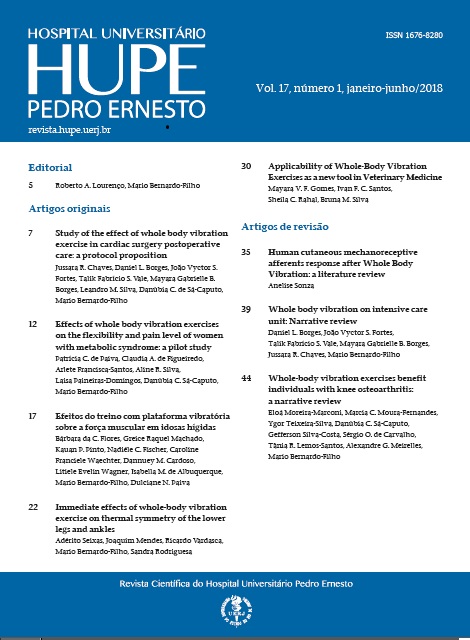Efeitos imediatos do exercício de vibração de corpo inteiro na simetria térmica das pernas e tornozelos
DOI:
https://doi.org/10.12957/rhupe.2018.39272Resumo
Introdução: O exercício vibratório de corpo inteiro (WBV)
tornou-se uma modalidade alternativa para exercício e reabilitação.
Poucos estudos abordaram o efeito desta modalidade
de exercício usando a temperatura da pele como medida de
resultado e menos estudaram o efeito da vibração do corpo
inteiro na simetria térmica. O objetivo deste estudo é avaliar
o impacto da exposição aguda ao exercício de vibração na
simetria térmica da parte inferior das pernas e tornozelos em
indivíduos saudáveis.
Métodos: A temperatura da pele de 36 indivíduos saudáveis,
não treinados, do sexo masculino e feminino, foi registada
usando termografia (camara FLIR A325sc), antes e após a exposição ao exercício de vibração ou situação de controle. Todos os indivíduos foram instruídos a despir-se e a permanecer sala de exame por 15 minutos para alcançar a estabilização térmica. A temperatura ambiente e a humidade relativa foram controladas,com ausência de fluxo de ar. A Power Plate® forneceu uma estimulação mecânica com parametros definidos em uma frequência de 35 Hz, alta amplitude (5-6 mm), resultando numa aceleração máxima de 121-145 m/s2, por 5 minutos.
Resultados: A simetria térmica foi maior na face anterior da
perna (0,17±0,13ºC) e menor na região lateral do tornozelo
(0,27±0,20ºC). A exposição aguda à WBV afetou significativamente
a simetria térmica em ambos os tornozelos, nas faces
anteriores e laterais (p≤0,05).
Discussão: Os resultados sugerem que a exposição a um exercício
agudo de vibração (35Hz) influencia a simetria térmica dos
tornozelos, embora o mecanismo subjacente a essas mudanças
exija que estudos futuros sejam totalmente compreendidos
em indivíduos saudáveis e pacientes.
Descritores: Temperatura da pele; Termografia; Vibração.
Referências
Mansfield NJ. Human Response to Vibration. United States of
America: CRC Press; 2005.
Rittweger J. Vibration as an exercise modality: how it may
v. 17, n. 1, jan-jun/2018 29
work, and what its potential might be. Eur J Appl Physiol.
;108:877–904.
Cochrane DJ. Vibration Exercise: The Potential Benefits. Int J
Sports Med. 2011;32(02):75-99.
Cardinale M, Bosco C. The Use of Vibration as an Exercise Intervention.
Exercise and Sport Sciences Reviews. 2003;31(1):3-7.
Lohman EB, Petrofsky JS, Maloney-Hinds C, et al. The effect
of whole body vibration on lower extremity skin blood flow
in normal subjects. Med Sci Mon Int Med J Exp Clin Res.
;13(2):CR71-6.
Kerschan-Schindl K, Grampp S, Henk C, et al. Whole-body
vibration exercise leads to alterations in muscle blood volume.
Clin Physiol. 2001;21(3):377-82.
Brengelmann G, Johnson J, Hermansen L, et al. Altered control
of skin blood flow during exercise at high internal temperatures.
J Appl Physiol (1985). 1977;43(5):790-4.
Charkoudian N. Skin blood flow in adult human thermoregulation:
how it works, when it does not, and why. Mayo Clinic
Proceedings. 2003;78(5):603-12.
Pascoe DD, MErcer J, Weerd Kd. Physiology of Thermal
Signals. In: Diakides M, Bronzino JD, PEterson DR, editors.
Medical Infrared Imaging - Prionciples and Practices. Boca
Raton FL: CRC Press; 2013. p. 6.1-6.20.
Burnham RS, McKinley RS, Vincent DD. Three types of
skin-surface thermometers: a comparison of reliability, validity,
and responsiveness. Am J Phys Med Rehabil. 2006;85(7):553-
Ring EFJ, Ammer K. Infrared thermal imaging in medicine.
Physiological measurement. 2012;33(3):R33-46.
Vardasca R, Ring EFJ, Plassmann P, et al. Thermal symmetry of
the upper and lower extremities in healthy subjects. Thermology
International. 2012;22(2):53-60.
Fernández-Cuevas I, Sillero-Quintana M, Garcia-Concepcion
MA, et al. Monitoring skin thermal response to training with
infrared thermography. New Stud Athl. 2014;29(1):57-71.
Cochrane DJ, Stannard SR, Sargeant AJ, et al. The rate of
muscle temperature increase during acute whole-body vibration
exercise. Eur J Appl Physiol. 2008;103(4):441-8.
Gold JE, Cherniack M, Hanlon A, Soller B. Skin temperature
and muscle blood volume changes in the hand after typing. Int
J Ind Ergon. 2010;40(2):161-4.
Games KE, Sefton JM. Whole-body vibration influences lower
extremity circulatory and neurological function. Scand J Med
Sci Sports. 2011;23(4):516-23.
Seixas A, Silva A, Gabriel J, et al. The Effect of Whole-body Vibration
in the Skin Temperature of Lower Extremities in Healthy
Subjects. Thermology International. 2012;23(12):59-66.
Seixas A, Vardasca R, Gabriel J, editors. The effect of different
vibration frequencies in the skin temperature in healthy subjects.
IEEE International Symposium on Medical Measurements
and Applications (MeMeA); 2014: IEEE.
Sonza A, Robinson CC, Achaval M, et al. Whole body vibration
at different exposure frequencies: infrared thermography and
physiological effects. The Scientific World Journal. 2015;2015.
Ammer K. The Glamorgan Protocol for recording and evaluation
of thermal images of the human body. Thermology international.
;18(4):125-44.
Schwartz RG. Guidelines For Neuromusculoskeletal Thermography.
Thermology International. 2006;16(1):5-9.
Moreira DG, Costello JT, Brito CJ, et al. Thermographic
imaging in sports and exercise medicine: A Delphi study and
consensus statement on the measurement of human skin
temperature. J Therm Biol. 2017;69:155-62.
Manimmanakorn N, Hamlin MJ, Ross JJ, et al. Long-term
effect of whole body vibration training on jump height: meta-
analysis. J Strength Cond Res. 2014;28(6):1739-50.
Tomczak M, Tomczak E. The need to report effect size estimates
revisited. An overview of some recommended measures
of effect size. Trends in Sport Sciences. 2014;21(1):19-25.
Bland JM, Altman DG. Statistical methods for assessing agreement
between two methods of clinical measurement. Lancet.
;327(8476):307-10.
Faul F, Erdfelder E, Lang A-G, et al. G*Power 3: A flexible statistical
power analysis program for the social, behavioral, and
biomedical sciences. Behav Res Methods. 2007;39(2):175-91.
Cohen J. Statistical Power Analysis for the Behavioral Sciences.
United States of America: Lawrence Erlbaum Associates; 1988.
Hazell TJ, Thomas GWR, DeGuire JR, et al. Vertical wholebody
vibration does not increase cardiovascular stress to static
semi-squat exercise. Eur J Appl Physiol. 2008;104(5):903-8.
Cochrane DJ, Stannard SR, Firth EC, et al. Comparing muscle
temperature during static and dynamic squatting with and
without whole body vibration. Clin Physiol Funct Imaging.
;30(4):223-9.
Roelants M, Verschueren SM, Delecluse C, et al.
Whole-body-vibration-induced increase in leg muscle activity
during different squat exercises. J Strength Cond Res.
;20(1):124-9.


